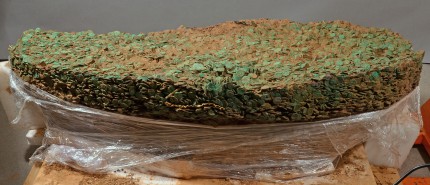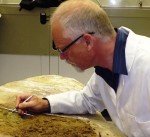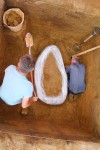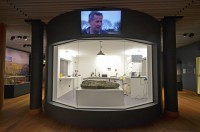
 The massive hoard of Celtic coins that was raised in a single block from a field on the Channel Island of Jersey in 2012 is proving to be even more precious a treasure trove than was immediately obvious, and that’s saying a lot since the Le Catillon II treasure is the largest Celtic coin hoard ever discovered. The original estimate of the number of coins by volume was 30,000 to 50,000. As the Jersey Museum’s conservator Neil Mahrer has worked his way down the hoard, unsticking the corroded coin cluster, the estimated number has increased to 70,000.
The massive hoard of Celtic coins that was raised in a single block from a field on the Channel Island of Jersey in 2012 is proving to be even more precious a treasure trove than was immediately obvious, and that’s saying a lot since the Le Catillon II treasure is the largest Celtic coin hoard ever discovered. The original estimate of the number of coins by volume was 30,000 to 50,000. As the Jersey Museum’s conservator Neil Mahrer has worked his way down the hoard, unsticking the corroded coin cluster, the estimated number has increased to 70,000.
 Finders Richard Miles and Reg Mead first began to search for the hoard when a woman told them a story 30 years ago about a pot of silver coins found when her father uprooted a tree on their farm in Grouville parish. She didn’t know exactly where this fabled discovery had happened but she knew the general area and Miles and Mead secured permission from the current landowner to search the field with metal detectors during the brief window between harvest and planting. Over the decades they scanned the property with no success until in February of 2012 they found 60 Celtic coins. They dug a little deeper and encountered a large solid object. Mead grabbed a handful of the soil on top and found a few silver coins inside. Being extremely responsible and awesome people, they immediately filled in the hole and alerted Jersey Heritage to the find.
Finders Richard Miles and Reg Mead first began to search for the hoard when a woman told them a story 30 years ago about a pot of silver coins found when her father uprooted a tree on their farm in Grouville parish. She didn’t know exactly where this fabled discovery had happened but she knew the general area and Miles and Mead secured permission from the current landowner to search the field with metal detectors during the brief window between harvest and planting. Over the decades they scanned the property with no success until in February of 2012 they found 60 Celtic coins. They dug a little deeper and encountered a large solid object. Mead grabbed a handful of the soil on top and found a few silver coins inside. Being extremely responsible and awesome people, they immediately filled in the hole and alerted Jersey Heritage to the find.
 It’s because of their dogged determination spanning three decades and their respect for the archaeological context that the Le Catillon II hoard was archaeologically excavated from the site and is now being archaeologically excavated in an extremely cool glass-walled laboratory in public view at the Jersey Museum. Richard Miles and Reg Mead are part of the conservation team. They’ve been particularly helpful in coin identification, classification and cleaning, and of course they’re superstars to museum visitors.
It’s because of their dogged determination spanning three decades and their respect for the archaeological context that the Le Catillon II hoard was archaeologically excavated from the site and is now being archaeologically excavated in an extremely cool glass-walled laboratory in public view at the Jersey Museum. Richard Miles and Reg Mead are part of the conservation team. They’ve been particularly helpful in coin identification, classification and cleaning, and of course they’re superstars to museum visitors.
 The first gold peeked through the vertical face of the hoard in July of 2012. When the green corrosion from the silver and silver alloy coins was washed away, a thin sheet of flattened and twisted gold that had once been a torc was revealed. Later that month, conservators found another gold torc above and to the left of the first one. Only a couple of inches of it were visible at first, but the curve looked proper to the original curve around the neck and there was no evidence of twisting or flattening. This tendered the exciting prospect that there might be an intact gold torc amidst the layers of packed coins.
The first gold peeked through the vertical face of the hoard in July of 2012. When the green corrosion from the silver and silver alloy coins was washed away, a thin sheet of flattened and twisted gold that had once been a torc was revealed. Later that month, conservators found another gold torc above and to the left of the first one. Only a couple of inches of it were visible at first, but the curve looked proper to the original curve around the neck and there was no evidence of twisting or flattening. This tendered the exciting prospect that there might be an intact gold torc amidst the layers of packed coins.
 It has been two and a half years since the first glimpses of torc, and only now have conservators gotten down to the layers where they are nestled. It took close to two years to get all the permits and funding sorted. During that time, Mahrer and the conservation team removed 2,000 loose coins from the surface and cleaned them. This summer, they were finally able to start work on taking apart the coin block, laser scanning each coin in the mass and after its removal to ensure they have as detailed a record of the block and coins at every possible stage. The hoard is too big and dense for X-rays to give conservators an excavation road map, so they’re only discovering what’s in there as they go along.
It has been two and a half years since the first glimpses of torc, and only now have conservators gotten down to the layers where they are nestled. It took close to two years to get all the permits and funding sorted. During that time, Mahrer and the conservation team removed 2,000 loose coins from the surface and cleaned them. This summer, they were finally able to start work on taking apart the coin block, laser scanning each coin in the mass and after its removal to ensure they have as detailed a record of the block and coins at every possible stage. The hoard is too big and dense for X-rays to give conservators an excavation road map, so they’re only discovering what’s in there as they go along.
 In the beginning the finds were coins and organic material. To preserve the organic material (mainly peat and plant stalks), the team had to move very slowly during the unsticking process. They found that, as expected, most of the coins in the hoard were staters and quarter staters of the Coriosolitae tribe. Unexpectedly, they regularly encountered petit billons, a small denomination that is so rare a few tens of them were known before this hoard. They’re so rare that nobody knows what tribe made them or when. Other numismatic surprises are two coins from the Osismii tribe, the Coriosolitae’s western neighbors: one a five-sided stater that contains some gold, one is a solid gold quarter stater of the Bull Standard type.
In the beginning the finds were coins and organic material. To preserve the organic material (mainly peat and plant stalks), the team had to move very slowly during the unsticking process. They found that, as expected, most of the coins in the hoard were staters and quarter staters of the Coriosolitae tribe. Unexpectedly, they regularly encountered petit billons, a small denomination that is so rare a few tens of them were known before this hoard. They’re so rare that nobody knows what tribe made them or when. Other numismatic surprises are two coins from the Osismii tribe, the Coriosolitae’s western neighbors: one a five-sided stater that contains some gold, one is a solid gold quarter stater of the Bull Standard type.
In November, they reached the torc area. The solid gold torc was first revealed to have a join in the back, a hole through which a pin would be inserted to close the piece around the neck. Then they found another much larger torc.
At first it appeared to be a thick, tightly curved gold torc but when cleaned back a bit it was revealed as a pair of solid gold “wheels” at the end of a thick, curved, gold torc collar. The wheels are about 4cm accross and the collar part about 15mm thick. We’ve now cleaned back enough coins to see that the torc appears to be constructed from two semi circular parts which would have fitted together to be worn. We’ve think we’ve exposed about 90% of the first part with the wheels and about 50% of the second. We don’t know what the other ends of both are like yet. The sheer size of this piece is amazing in comparison to everything else we’ve seen yet and the torc surface appears to be in good condition and of a very pure gold.
And then they found even more:
In the same way that we found the large torc while clearing around another one, we have continued to find more new pieces as we cleared around it. We’ve found another of the sheet gold objects long visible on the hoard’s side. This new one seems very similar but is possibly in better condition. We have also partially uncovered two other smaller diameter possibly solid gold torc sections, one towards the rear of the hoard and another towards its centre. As such we just don’t know how far the rich area of jewellery extends throughout the hoard’s body, but it’s certainly further than we initially thought. What we are going to do over the next few months therefore is to extend the coin removal out from the torc area to a 5cm depth over the whole surface and see what we find.
That makes a total of six torcs — five gold, one gold-plated — found so far in an area the size of a shoebox. For more about the history of the coins, the hoard and its discovery, check out the Treasure Island page on the Jersey Heritage website. Keep your eye on Neil Mahrer’s Treasure Island Blog to follow the exciting developments as the conservation continues.
This was a great read. One can only imagine what else they’ll find as they remove more coins. Very exciting! Thanks for sharing and I’ll be following the Treasure Island pages you shared for updates.
Torcing, torcing, torcing
Happy torc.
Are there any figures for how much coinage and precious metals have been discovered in buried hoards, and estimates of how much might remain to be discovered? Could so much have been buried that it substantially impacted trade and economic development?
Gaius Julius Caesar, talking about himself in ‘Gallic War’ (Bk. III, 10/11): “…There were these difficulties in carrying on the war, … He …
… sends Quintus Titurius Sabinus his legate, with three legions, among the Venelli, the CORIOSOLITES [!], and the Lexovii, to take care that their forces should be kept separate from the rest. [Bretagne, English Channel]
… appoints Decimus Brutus, a young man, over the fleet and those Gallic vessels which he had ordered to be furnished by the Pictones and the SANTONES [where the later ‘Gallo-Roman necropolis’ was found], and the other provinces which remained at peace …”
—
cf.: en.wikipedia.org/wiki/Quintus_Titurius_Sabinus
So many questions about the story of the hoard. It seems to be a collection of every possible item of portable wealth. Who would such a large hoard belong to? Perhaps a very wealthy individual, or the booty of a raid, though that leaves the question of why it would be buried. I wonder if it was the collective wealth of a community? If so, what was the peril they were apparently so desperate to flee they left their hidden wealth behind and never returned to reclaim it? What happened to them: killed or enslaved or simply scattered and unable to return? Perhaps somewhere there is a documentary clue, but like so many things like this, I suppose the best anyone can do is surmise from the general picture that records and archaeology can provide.
Fascinating story. Many thanks!
I had never heard of a torc before. Now that I’ve looked it up, this story is much more understandable!.
Can hardly wait for further results. The ‘shape’ of the ‘caked’ hoard seems to almost indicate that it had been stored in some sort of vessel.
Chief ‘Moralelastix’, a neighbouring miser from ‘Asterix and the Cauldron’, asked the people of Asterix’s village to keep his money away from the imminent visit of roman tax collectors, money which is then promptly stolen during the night… : Map: Gallia, tribes and towns. 😀
Great article …but through it I found your wonderful blog. Great to get depth and detail. I would be interested if you have more knowledge of this extraordinary hoard.
Wonderful reading!
Wonderful, such endeavour and persistence. Great article